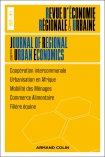
REVUE D'ÉCONOMIE RÉGIONALE ET URBAINE (5/2022)
Pour acheter ce numéro, contactez-nous
Recevez les numéros de l'année en cours et accédez à l'intégralité des articles en ligne.
Depuis le milieu des années 1990, une nouvelle forme d’activités sexuelles marchandes (ASM) emblématique de la numérisation se développe rapidement : le sexcam (Jones 2020, 2016, 2015 ; Brasseur et Finez, 2020 ; Bleakley 2014). Les formes territoriales de ces activités expliquent leur essor, notamment parce que la numérisation rend possible une nouvelle division spatiale de la production et de la consommation. De plus, le contenu des services proposés se transforme, en comparaison avec les formes traditionnelles et plus concrètes d’ASM. Cet article vise à discuter des impacts de la numérisation et de l’économie des plateformes sur les activités sexuelles marchandes par la mobilisation de l’approche d’Adams (2010) sur la relation entre médias et espaces et celle de Hubbard et al. (2017) sur les liens entre espaces publics et privés, ville et sexe.
Since the mid-1990s, a new form of commercial sexual activity (CSA) emblematic of digitalization has been developing rapidly: sexcam (Jones 2020, 2016, 2015; Brasseur and Finez, 2020; Bleakley, 2014). The territorial and temporal forms of these activities explain their rise, particularly because digitalization makes possible a new spatial division of production and consumption. By mobilizing Harcout and Donovan’s (2005) dichotomy between direct and indirect sex, this article proposes to articulate the CSA market between digital and concrete spaces. A mixed methodology composed of both qualitative interview data, digital data and secondary documentation is mobilized, in order to understand how the use of digital allows for low production costs, the avoidance of certain dedicated concert spaces and thus the avoidance of certain stigmas on the part of both clients and performers. By comparing sexcam with traditional and more concrete forms of CSA through Tabet’s (2004) continuum, the article studies the way in which the content of the services offered is spatio-temporally transformed. In this comparative perspective, the mobilization of the notions of scenes (Guex and Crevoisier, 2015) will also allow to decompose the spaces and temporality of a typical sexcam transaction. In summary, this article aims to discuss the impacts of digitization and the platform economy on commercial sexual activities by mobilizing different approaches : Adams’ (2010) on the relationship between media and spaces, Hubbard et al.’s (2017) on the links between public and private spaces, city and sex, and the Global Production Network (GPN) on the subject of market and transactions.

